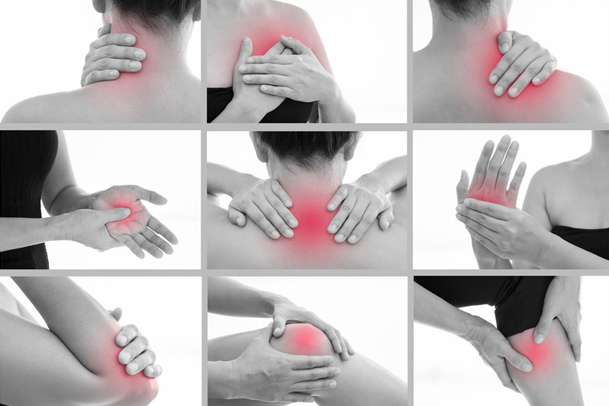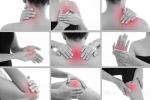
Overview
Musculoskeletal pain refers to pain in the muscles, bones, ligaments, tendons, and nerves. You can feel this pain in just one area of the body, such as your back. You can also have it throughout your body if you have a widespread condition like fibromyalgia.
The pain can range from mild to severe enough to interfere with your day-to-day life. It may start suddenly and be short-lived, which is called acute pain. Pain that lasts for more than 3 to 6 months is called chronic pain.
Causes
Musculoskeletal Disorders
These disorders directly affect the bones, muscles, joints, and ligaments. The most common cause of musculoskeletal pain is an injury to the bones, joints, muscles, tendons, or ligaments. Falls, sports injuries, and car accidents are just a few of the incidents that can lead to pain.
More than 150 different musculoskeletal disorders exist. Some of the most common ones are:
- arthritis, including rheumatoid arthritis, psoriatic arthritis, lupus, osteoarthritis, gout, and ankylosing spondylitis
- osteoporosis
- injuries such as fractures and dislocations
- muscle loss (sarcopenia)
- problems with the structure of bones or joints, such as scoliosis
Non-Musculoskeletal Disorders
These are a few of the non-musculoskeletal disorders that cause pain in the bones, muscles, joints, and ligaments:
- overuse at work or while playing sports
- poor posture
- prolonged bed rest, such as during an illness or after surgery
- infections of the bones, muscles, or other soft tissues
- tumors that put pressure on tendons and bones, including tenosynovial giant cell tumors (TGCTs) like pigmented villonodular synovitis (PVNS)
Pain can sometimes feel like it’s originating in the musculoskeletal system when it’s from another organ system entirely. For example, a heart attack can cause pain that radiates down the arm. This is called referred pain, and it can stem from the:
- heart
- lungs
- kidneys
- gallbladder
- spleen
- pancreas
Types
Lower back pain is the most common type of musculoskeletal pain. Other types include:
- muscle pain (myalgia) from an injury, infection, cramp or spasm, loss of blood flow to the muscle, or tumor
- bone pain from an injury such as a fracture, infection, tumor, or hormone disorder
- tendon and ligament pain, such as from a sprain, strain, or inflammation from tendonitis or tenosynovitis
- joint pain from arthritis
- fibromyalgia, which causes pain in tendons, muscles, and joints throughout the body
- nerve compression pain from conditions that put pressure on nerves, such as carpal tunnel syndrome, cubital tunnel syndrome, and tarsal tunnel syndrome
Signs and symptoms
The quality of the pain can vary based on where it’s located.
Bone pain is dull, sharp, stabbing, or deep. It’s typically more uncomfortable than muscle or tendon pain.
Muscle pain can be intense and short-lived if it’s caused by a cramp or powerful muscle contraction, commonly called a Charley horse. The muscle may twitch or contract uncomfortably.
Tendon pain may feel sharp if an injury caused it. It usually worsens when you move or stretch the affected tendon, and improves with rest.
Joint pain feels like an aching. It may be accompanied by stiffness and swelling.
Fibromyalgia causes multiple tender spots throughout the body.
Nerve compression pain may have a tingling, pins-and-needles, or burning quality. Other symptoms depend on the cause of the pain, and can include:
- stiffness
- soreness
- swelling
- redness
- cracking or popping sound in the joint
- trouble moving the affected area
- weakness
- fatigue
- difficulty sleeping
- muscle spasms or twitches
- bruising
Diagnosis
Because musculoskeletal pain can have a variety of causes, your doctor will first take a detailed medical history and ask about your symptoms. Expect to answer questions like these:
- When did the pain start?
- What were you doing at the time (for example, working out or playing sports)?
- What does it feel like — stabbing, burning, aching, tingling?
- Where does it hurt?
- What other symptoms do you have (trouble sleeping, fatigue, etc.)?
- What makes it worse or better?
Your doctor might press on or move the affected area into different positions to find the exact location of your pain. A number of tests can help pinpoint the cause of your pain, including:
- blood tests to look for signs of inflammation that might suggest arthritis
- X-rays or CT scans to find problems with the bones
- MRI scans to find problems with soft tissues such as muscles, ligaments, and tendons
- joint fluid testing to look for infections or the crystals that cause gout
Non-Surgical Treatment
Primary care doctors most often treat musculoskeletal pain. Physical therapists, rheumatologists, osteopaths, orthopedic specialists, and other specialists may also be involved in your care.
The treatment you receive is based on what’s causing your pain. Treatment options are broken down into several types.
Hands-on therapy
- therapeutic massage
- chiropractic/osteopathic manipulation
- physical therapy
Alternative Therapies
- acupuncture
- herbal, vitamin, and mineral supplements
Aids and Devices
- orthotics
- braces
- cervical collars
- taping
- lumbar supports
Lifestyle modifications
For injuries or problems related to overuse, your doctor might recommend resting the affected body part until it heals. If you have arthritis or other muscle pain, doing some stretching and other exercises under the direction of a physical therapist may be helpful.
Ice and heat are both good options for soothing pain. Ice brings down swelling and relieves pain immediately after an injury. Heat alleviates stiffness a few days after the initial injury.
Sometimes it’s helpful to talk to someone about your pain. Cognitive-behavioral therapy (CBT) teaches you ways to manage your pain more effectively.
Takeaway
Musculoskeletal pain can have many sources, a few of which aren’t in the muscles, bones, and joints themselves. If you have pain that’s severe or that doesn’t improve in a few weeks, see your doctor for a checkup to find the cause.
Precision Pain Care and Rehabilitation has two convenient locations in Richmond Hill – Queens and New Hyde Park – Long Island. Call the Richmond Hill office at (718) 215-1888, or (516) 419-4480 for Long Island office, to arrange an appointment with our Interventional Pain Management Specialist, Dr. Jeffrey Chacko.













